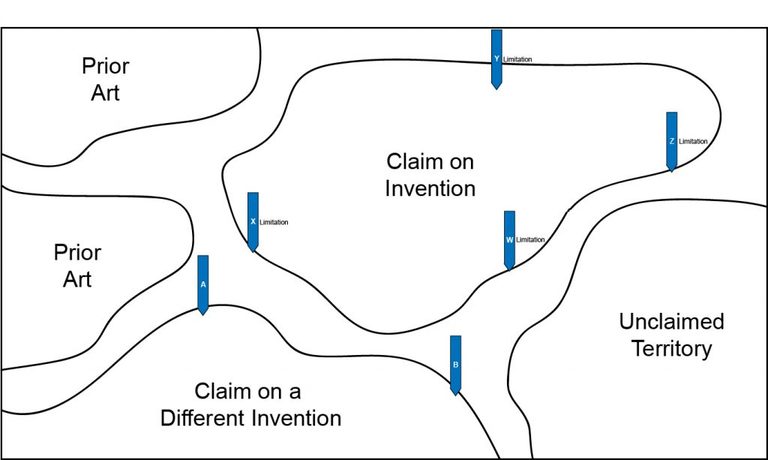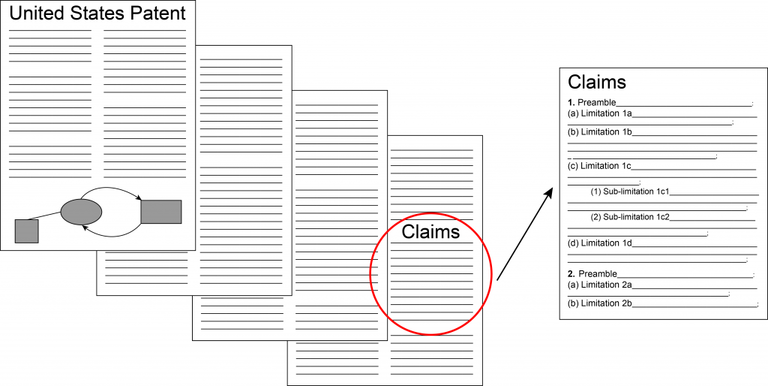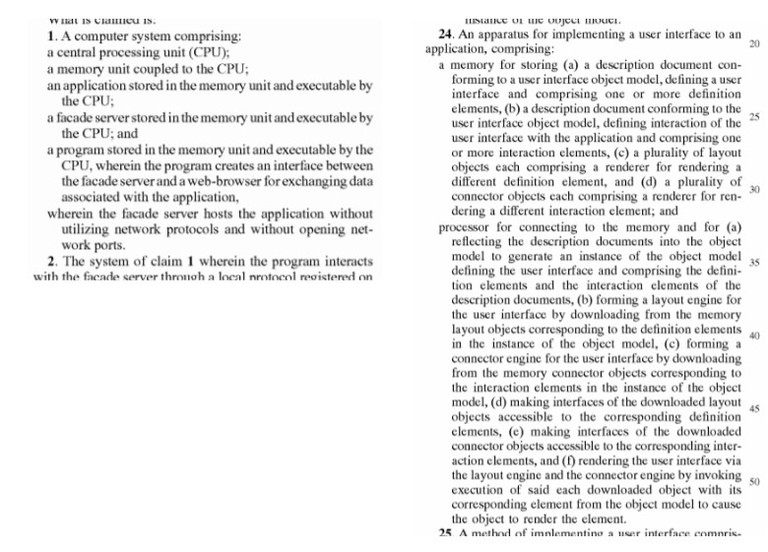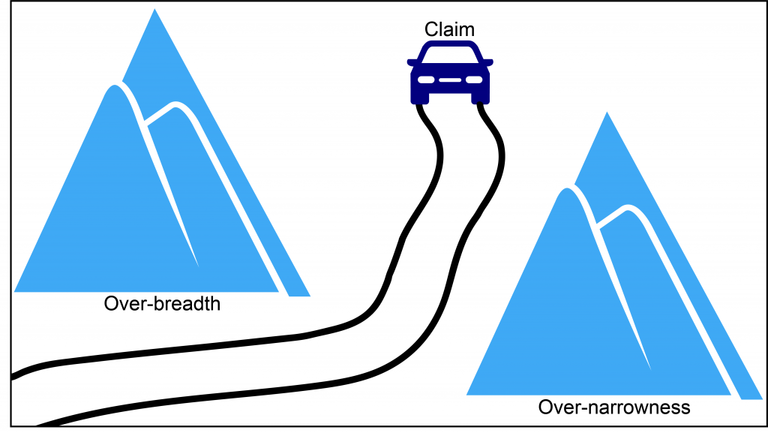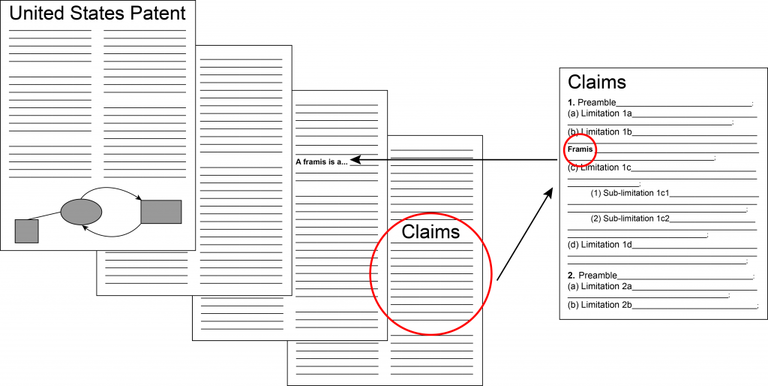
DisputeSoft presents the second in a series of articles authored by our colleague Andrew Schulman, who introduces readers to patent claims and the role of those claims in patent litigation.
The articles are drawn from Andrew’s book, Claim Charts: Marshalling Facts in Patent Litigation, currently in preparation for publication, and are also available on his website, softwarelitigationconsulting.com.
In the first article, Andrew discussed how patents help turn inventions into tangible, protectable property, and he noted that a patent is not self-enforcing but rather a right to sue others for infringement.
In this article, Andrew draws on a simple claim for printer toner to illustrate the role of patent claims. Andrew states that patent claims “serve as devices for testing patent infringement and invalidity,” and indicate the scope of a claim, i.e., the relative size of an area of technology protected by a claim. Andrew goes on to discuss the limitations that comprise a claim (selected elements or steps implementing an invention), and the role these limitations play in determining claim scope and the likelihood that a claim will be infringed.
Upcoming articles in this series will cover topics such as comparing a patent claim to an accused product, defending against patent infringement, investigating possible infringement or invalidity, and using claim charts for analyzing infringement and invalidity. Make sure to check back in two weeks for the next installment.
In Part 1 of this six-part series, we discussed how patents help turn inventions into tangible, protectable property, and made the following points:
- A patent by itself does little, and needs enforcement primarily through litigation or credible threat thereof.
- Indeed, the patent property is largely a right to sue others for infringement.
- Patent infringement is similar in some ways to trespassing on land.
- The actionable part of a patent is its “claims.”
- A patent claim is like a collection of stakes marking out the perimeter of a patented invention.
In this Part 2, we’ll look carefully at a simple claim for printer toner, and at the so-called “limitations” that make up this patent claim. Along the way, the following points will be made:
- Patent claims serve as devices for testing patent infringement and invalidity.
- Patent claims are made up of limitations, which are selected elements or steps implementing an invention.
- The set of limitations comprising a patent claim is not complete, but instead the subset necessary to differentiate the claim from prior art, while still trying to leave a wide scope of infringement.
- The size of a patent claim is an indication of claim scope (e., whether a claim protects a large or small area of technology).
- Adding limitations generally reduces claim scope, but generally increases likelihood of validity.
- “Claim construction” uses the patent specification (and a hierarchy of other sources) to interpret the meaning of terminology in a claim.
- The boundaries of patent property are determined in part by steering between infringement and invalidity.
A sample patent claim
What does a patent claim look like? Rather than a contrived example, let’s use a genuine claim. While my focus is software and networking, it’s often easier to understand patent claims with more tangible subject matter. Below is claim 1 from a Fuji Xerox patent (US 8,951,704), related to printing:
- A toner comprising:
- a crystalline polyester resin having an unsaturated double bond;
- a thiol compound having a bi- or more-functional thiol group; and
- a photopolymerization initiator.
There is a lot to say about even this simple example, and throughout, we’ll be asking how something that looks like a mere parts list helps protect an invention.
The claim contains a preamble (“A toner”), transition (“comprising”) and three ingredients which, as we’ll see later, serve as what are called “limitations” to the claim.
Leaving aside “A toner comprising” for the moment, for something to infringe this patent claim, it must have all three ingredients. If a competitor’s product only has the resin and initiator, for example, but not the thiol compound, there isn’t infringement. Similarly, if the resin isn’t a crystalline polyester resin, or doesn’t have an unsaturated double bond, there likely isn’t infringement (only likely because of the possibility of infringing with non-identical “equivalence,” which we’ll discuss later in this series).
But what is done with the three ingredients? As we discussed in Part 1, US law (35 USC 271) defines patent infringement. Simplifying somewhat, someone must make, use, or sell something containing all three ingredients in order to infringe.
Infringing this particular patent claim would require that someone assemble all three listed ingredients. This in itself would (apart from a narrow exception for “experimental use”) constitute making the invention, and thus infringement. The maker might also be using or selling it (which is likely how the patent owner could come to learn of the infringement).
The mere act of buying these ingredients would not infringe, nor would buying a kit containing all three. However, using such a purchased product would infringe (though the patent owner will generally prefer to go after a single deep-pockets vendor rather than individual customers; we’ll discuss direct vs. indirect infringement later in this series).
Perhaps surprisingly, a combination of the three ingredients probably need not be used or sold as a toner to still infringe. A claim preamble (here, “A toner”) is often held to be non-limiting, i.e., not a required element or step. Here, the three ingredients might form a floor wax or dessert topping, and still infringe. A defendant using the three ingredients in a floor wax could argue that the word “toner” is vital to the patent claim, and therefore that its floor wax doesn’t infringe. However, patent law generally cares more about structure or implementation than about function or purpose.
We will look at each of the three ingredients in detail when we discuss claim construction.
The transition word “comprising” indicates that the accused product could contain additional elements and still infringe (the less-frequently used word “consisting” indicates a closed rather than open set of limitations).
As a further important nuance, having just said that someone must assemble all three listed ingredients to infringe, the claim actually says nothing about mixing or combining the three limitations. Indeed, this claim is somewhat unusual in not saying anything explicit about how its limitations interrelate. Usually a claim recites some connections (even if seemingly vague, like “based on” or “associated with”) amongst its limitations.
From the claim limitations, one might infer that the “photopolymerization initiator” is intended to initiate a light-sensitive (photo) process, maybe in the polyester resin. But that need not actually occur to infringe (in part because this is not a method claim; see below). A competitor’s product that infringes this claim might be more like a loosely-coupled kit, in which something interesting only occurs when the ingredients are brought together — but that bringing together isn’t part of this claim. When working with a patent claim, one must pay attention to what the claim says (or doesn’t) about when infringement happens.
Patents can contain dependent claims, which incorporate by reference other claims. Non-dependent claims, like claim 1, are called independent claims. This patent includes several dependents upon claim 1, including:
- “10. A dry developer comprising the toner according to claim 1.” and
- “11. A developer cartridge containing the dry developer according to claim 10.”
Not jumping into these dependent claims, but merely using them to help understand claim 1, these tell us that, to infringe claim 1, an accused product need not be dry developer nor contained in a cartridge, because otherwise claims 10 and 11 would be unnecessary. While all claims in a patent refer to a single invention, each claim is presumed to have a different scope. When we discuss claim construction, we’ll also see that an independent claim can’t be interpreted in a way that would render one of its dependents impossible. Therefore, dependent claims help tell us about non-required examples of independent claims. Here, when searching for products that infringe claim 1, dry developer (from claim 10) and developer cartridges (claim 11) would be good examples to look for (as long as they also contained the three ingredients).
Putting together what we’ve said so far about this simple patent claim, having merely to loosely put together only three things (or even, as we’ll discuss later in this series, their non-identical equivalents) and thereby walk, or inadvertently fall, into the staked-out field of infringement – even if one adds additional ingredients, and uses the results for some purpose other than toner – doesn’t sound like very much. If this is a representative example, it almost sounds as if a patent claim is a trap for the unwary. However, I deliberately chose a short, simple example. We’ll soon see that, all things being equal, a short patent claim is easier to infringe than a lengthy patent claim.
A sample patent claim for a method
It’s useful to briefly glance at another claim from the same patent as our toner example:
- An image forming method comprising:
- forming a latent image on a surface of an image holding member;
- forming a toner image by developing the latent image, which is formed on the surface of the image holding member, using the liquid developer according to claim 13; [Claim 13 is a liquid developer, based on the toner in Claim 1]
- transferring the toner image, which is formed on the surface of the image holding member, onto a recording medium;
- forming a fixed image by fixing the toner image, which is transferred onto the recording medium, on the recording medium; and
- curing the fixed image.
This is a method claim, made up of steps in a process. Note how each step in the process above begins with an -ing word (gerund); it is the activity itself that is being claimed and protected. Contrast the claim for the toner (claim 1), which covers a static combination.
This claim 16 depends on claim 13, which in turn depends on our toner in claim 1. If claim 1 or 13 aren’t infringed, neither will be claim 16. However, and somewhat counterintuitively, even if claim 1 or 13 are invalid, claim 16 might still be valid; this is discussed later in this series.
While the steps in a method claim need not necessarily be performed in a given order, one step often depends on other steps. Here for example, forming the toner image depends on having already formed the latent image.
As noted earlier, the word “comprising” toward the top of the claim indicates an open list. Here, an infringing process might include additional steps. This suggests that the claim is not necessarily a complete set of directions for carrying out the process. Now, what would be the point of providing only partial directions? To get slightly ahead of ourselves, the lists that make up claims are generally, and deliberately, not complete. While more complete directions would be found in the rest of the patent document, as we’ll see, the claims tend to list a minimum number of elements or steps necessary to distinguish the invention from the “prior art” (i.e., previous publicly-accessible disclosures of technology).
We’ll later look more carefully at each of the three limitations that make up the earlier toner example, when we discuss claim construction, but let’s first step back and look at claims in general. In particular, let’s ask how something as simple as a partial list of ingredients, or a partial set of directions for a process, helps protect an invention.
Patent claims are made of “limitations”
Part 1 stated that a patent claim represents the perimeter of stakes in the ground showing where the patent owner has the exclusive right (for the temporary life of the patent) to exploit the invention. We also know from Part 1 that this exclusive right is not self-acting, but requires enforcement by the patent owner, such as litigation against someone who has already infringed the exclusive right. The result of such a lawsuit might be an injunction forbidding continued infringement, but is more likely to be monetary damages compensating the owner for the infringement. Thus, the exclusive right is not like an electrified barbed-wire barrier that actually prevents entry, but rather like a set of stakes in the ground with clearly-posted “No Trespassing” signs.
So, if a patent claim is a collection of stakes marking out an enclosed perimeter, what then are the individual stakes that make up the claim?
As seen above in the toner example, patent claims generally consist of individual components, elements, or ingredients; a claim looks somewhat like a parts list. As we also saw, another type of patent claim lists steps in a process or method.
The term “element” is used for the parts or components of an apparatus (a device or machine); the term “step” is used for a stage in a method or process. “Apparatus” and “method” are two types of patent claims; others include compositions of matter; articles of manufacturer; systems; and computer-readable media.
The individual elements or steps of a claim themselves usually have additional attributes, such as adjectives (e.g., a gold-plated grommet, rather than simply a grommet). In the toner example, the first component isn’t just any resin, but a crystalline polyester resin, and not just that, but one with an unsaturated double bond.
While not in our toner example, the elements or steps in most claims typically have inter-relations with other elements or steps (e.g., the grommet is aligned to receive a curtain rod). In the image-forming method claim, we noted that forming the toner image requires having already formed the latent image.
The elements or steps of patent claims are often called “limitations.” These limitations, and any interrelations they have, are the stakes that comprise the perimeter of the invention, as illustrated below in Fig. 1.
Figure 1: Limitations (elements of a device, or steps in a process) act as “stakes” marking out the perimeter of a claim to a patented invention, separating it from prior art, from claims on different inventions, and from currently unclaimed territory in the virtual space of inventive technology.
Yes, it sounds odd to use a negative-sounding word for what constitutes a positive piece of property (“limitations? why would I as the patent owner want those?!”). However, any boundary-marker not only shows where the property is, but as importantly sets its limits or boundaries. Indeed, it is precisely by marking those outer limits that such a marker helps define the property. The real-property term is “metes and bounds,” designating a trip around the boundaries of the property, and this term is also used within patent law. If a government agency is going to grant a temporary monopoly over an invention, the agency and the public should know where the invention begins and ends. From this perspective, the outer boundary of the invention is more important than what’s inside the boundary. While the entire patent document should describe what’s inside the invention (how to make and use it), the claims trace the outer periphery of the invention.
Thus, a patent claim is supposed to describe the boundaries of the invention (what differentiates it from other technology), rather than what is inside (its implementation). This is called “peripheral claiming,” in contrast to the older use of small models of the entire invention. To get a patent and pursue infringers, first one must be able to show how the claims differ from the prior art. What separates the claimed invention from the prior art is what determine its boundaries. When crying “infringement!,” the accused thing or act had better not look exactly like the prior art (nor like an obvious non-inventive variant). The gap or delta between a patent claim and the prior art will likely depend in part on negotiations with the patent examiner at the PTO.
The relationship of limitations to claims, and of claims to the patent as a whole, is illustrated in Fig. 2 below. The attributes of limitations (like “crystalline” and “polyester” in the resin limitation in the toner claim) act almost like further sub-limitations; some patent claims contain explicit sub-limitations, and this too is shown in Fig 2. Borrowing from film noir and pulp fiction lingo, we can say that the claims are the “business end” of the patent, and that the rest of the patent is a handle that allows the claims to be grasped. We’ll complicate this picture later in Fig. 4, showing that a claim must be read in context of the patent as a whole, in order to properly use the claim as a device for detecting infringement or invalidity.
Figure 2: The “business end” of a patent is the Claim, and Claims include Limitations, which often include Sub-limitations. The rest of the patent provides a handle with which the “business end” may be grasped.
How parts lists serve as patent boundary markers
When looking earlier at the image-forming method claim, we noted that the claimed steps in the process were likely not complete, and likewise that the ingredients in the toner example were not necessarily a complete list.
A patent claim typically does not list all components of the invention. If it does, it is called a “picture patent”; such a “complete” patent claim is rare, and sometimes associated with scams aimed at inventors. Patent claims typically differ in significant ways from what the inventor originally thought of as his or her invention. Inventors, especially at large companies, may joke that they don’t even recognize their work in the patent.
An exact mapping of the patent to the inventor’s conception is not a good idea, because such a mapping, complete with all components, would likely be easy for competitors to “design around”: make one small change (“the claim is for a red framis, so we’ll make it a green one”) and walk away from infringement. Thus, a patent attorney will generally try to claim a larger area that is more difficult to design around. See Ronald Slusky’s excellent book, Invention Analysis and Claiming.
As discussed below in the section “Less is More,” claiming a larger area often involves fewercomponents or steps than might be needed to carry out an invention. The patent document as a whole must disclose nearly-complete instructions on how to make and use the claimed invention (nearly, because the document is directed at skilled practitioners who don’t need to be told every last detail, and who may even need to do a reasonable amount of experimentation). But so long as this disclosure exists, a patent claim need only include the minimum necessary to separate itself from prior art and from unclaimed territory.
On the other hand, the inventor may not appreciate what separation is required between the invention and prior art. Thus, a patent attorney (especially during negotiations with the patent office) may add limitations to a claim to maintain a proper distance from the prior art, while trying to minimize the requirements to later use the claim to find infringement; we’ll see a good example in a software patent in Part 4.
Thus, claiming a minimum set of limitations is not a matter of elegance, but rather of letting a patent on the one hand claim as much territory as possible (maximizing potential infringement), without on the other hand overly risking invalidity from the prior art.
Part 1 of this series stated that patent litigation “involves identifying locations where the components of patented inventions are found in products accused of infringing the patent, or in so-called ‘prior art’ said to show that the patent is invalid.” We can now see that this more accurately refers to certain selected components — the ones that form a patent claim, i.e., the limitations.
Patent claims are devices for testing infringement and invalidity
One uses these claim limitations to detect and show (or disprove) patent infringement or invalidity.
Something in the real world only infringes the patent claim if all claim limitations are present in that thing. If the claim contains limitations X, Y and Z, the infringing product must be shown to contain each and every one (or its equivalent). A defendant (D) rebuts the accusation of infringement by showing that its product is missing at least one element or step found in the patent claim. In other words, the patent owner (P, or plaintiff) is running an AND function, and D an OR.
These postures are reversed when D asserts that the patent claim is invalid because of the prior art: D must show that all of X, Y and Z were known in (or obvious from) the prior art; P need only show that one of them (X, Y or Z) was not. A patent claim serves not only an infringement-detecting device, but also as a device for determining its own potential invalidity.
A patent claim provides a way of determining what matches and what does not, what’s in and what’s out. English IP scholars Alain Pottage and Brad Sherman have nicely described patent claims as “litigation machines” for detecting infringement and invalidity. Patent claims don’t describe inventions so much as describe devices for testing infringement and invalidity.
While the value of patent claims may be quite uncertain, patent law requires that the claim be sufficiently particular and distinct (35 USC 112(b)) that a reasonably-skilled but non-inventive person in the field (known as the PHOSITA, or “person having ordinary skill in the art”) could use the claim to test whether something infringes.
This is an important part of providing “notice” to potential infringers: it’s not simply announcing “I have a patent,” or stamping the patent number on your product (see Part 1) that acts as “No Trespassing” notice to potential infringers; it’s the claims of the patent that constitute the patent “No Trespassing” sign. Part 1 stated that such notice is one of the reasons this form of intellectual property is called a “patent.” The word patent (in contrast to “latent”) means: open, overt not covert.
At the same time, while patent notice is supposed to be precise, its wording may be somewhat difficult to understand. For example, the patentee is allowed to act as “its own lexicographer,” creating new words or phrases, or even using existing ones in idiosyncratic ways, so long as these are spelled out in the non-claims part of the patent. To understand the meaning of words or phrases in a claim, one uses claim construction, discussed below.
Often, the operative meaning of a claim term — i.e., whether a specific component of an accused product matches a given claim limitation — won’t be fully known until litigation. Further, the Doctrine of Equivalence (DoE) acts as a “penumbra” around the claim perimeter. The difficulty of matching claim limitations to allegedly-infringing products similarly applies when comparing claim limitations to prior art which is said to invalidate the patent claim. Here too, there is a penumbra around the claim, in the form of “obviousness.” Equivalence and obviousness will be discussed later in this series.
Claim scope: Less is more
We noted earlier that it didn’t sound like it would take much to infringe the short sample patent claim for toner: loosely assemble three ingredients, and bam, you’ve infringed. While a good example because it is so short, its brevity makes it atypical. In a list of over 5,000 randomly-chosen patent claims, lifted out of their patents and sorted by their length, this was one of the shortest claims. Most patent claims are longer than this, and include more elements.
All things being equal (depending on, e.g., the rarity or commonness of the limitations themselves), more limitations make the claim harder to infringe, and (what is not quite the same thing) make it harder for the patent owner to detect infringement. Oversimplifying, fewer limitations imply wider scope (where “scope” refers to what the owner has a right to exclude others from making, using, or selling). This is one reason the toner example seemed so prone to infringement.
This ‘Less Is More’ quality to patent claim elements and steps is another reason the word “limitation” was aptly chosen. Some engineers have a difficult time wrapping their minds around how a shorter claim, with fewer elements, has a wider scope of potential infringement, and how the addition of claim elements narrows the scope of potential infringement. Many of us are accustomed to thinking that adding ingredients makes something better (eleven “secret herbs and spices” sounds better than just two). But this is definitely not true when using patent claims as devices for detecting infringement.
Fig. 3 below shows a side-by-side comparison of a short claim, with a much longer claim in the same technology area. Reader, just from a quick overall impression, which patent claim below would you rather own?
Fig. 3: A short claim from 7,472,398 (left), and a lengthy claim from 6,717,593 (right).
Many engineers will react that there’s nothing to the short claim on the left from ‘398, but as to the longer one on the right from ‘593, “okay, now you’re talking, that’s something I can sink my teeth into.”
However, if you want to use one of these claims as something to capture infringement and monetize it, and if we assume both are valid claims, you’re better off using the short one on the left rather than the longer one on the right. It is much easier to determine whether someone infringes the shorter claim. Stop reading this text, and stare at Fig. 3, until you are convinced of this.
On the other hand, a short claim, all things being equal, is also less likely to be valid against the prior art. A patent law adage says “That which infringes, if after, invalidates, if before.” This infringement/invalidity mirror image is an important reason why patent owners, despite the preference for wider scope of infringement, nonetheless add limitations, to help distinguish their invention from prior art.
So, as a general rule, a short claim is more likely to be infringed but also to be invalid; a long claim is more likely to be valid but less likely to be infringed. Patent drafting and litigation require steering the claim between the extremes of over-breadth and over-narrowness, as illustrated below in Fig. 4.
Figure 4: Patent drafting and litigation require careful navigation between two extremes: over-breadth and over-narrowness. A short claim is more likely to be infringed but also to be invalid, while a long claim is more likely to be valid but less likely to be infringed.
Each side using patent claims in litigation must “thread the needle” between infringement and invalidity. This helps keep the parties to patent litigation (and their technical experts) from taking unreasonable positions. If an expert testified that client P’s “opaque green solid” (OGS) limitation applies to (“reads on”) a translucent pale-green semisolid (TPS) in D’s accused product, P is likely also stuck with a TPS in the prior art helping invalidate P’s patent; what’s sauce for the goose is sauce for the gander. A patent claim is not a “nose of wax,” to be twisted one way to avoid invalidity, and another way to capture infringement.
While the tension or balance or mirror image between infringement and invalidity is crucial to understanding patent litigation, it is also important to note that the mirror image in not exact. For one thing, showing invalidity in litigation carries a more difficult burden of proof than does showing infringement; as explained in Part 1, the starting presumption in litigation of patent validity is one of the key features of patent protection. For another thing, the roles of equivalence in infringement and of obviousness in invalidity, while superficially similar, are not mirror images.
The role of claim construction in patent litigation
Returning to the toner example, even a reader without a background in chemistry likely feels that these three ingredients are definite and certain things. We’ll later contrast the field of software in which claims may include terminology (such as “server” or “client”) that may be more open to interpretation, or require more context to understand.
Even so, even the three ingredients listed in the toner example are not self-defining. In the remainder of this Part 2, we’ll look at several ways of understanding the meaning of individual claim limitations.
Dependent claims were noted earlier. Dependents can provide examples for individual limitations or terminology within an independent claim. For example, claim 7 of the toner patent reads:
- “7. The toner according to claim 1, wherein the thiol compound is pentaerythritol tetrakis(3-mercaptobutylate).”
This is relevant when working with claim 1 because it tells you that while the thiol compound back in claim 1 need not be this (otherwise claim 7 would be superfluous, and each claim is presumed to have different scope), on the other hand this is still one example of the thiol compound limitation.
Specific examples of general terms can be at least as useful as the general terms themselves when doing a search. When the patent owner searches for infringement, it might be more productive to search for “pentaerythritol tetrakis(3-mercaptobutylate)” than for “thiol compound”. Such a search would not capture all potential infringers employing a thiol compound, but it would be a reasonable place to start looking. A quick Google search for “pentaerythritol tetrakis(3-mercaptobutylate)” indicates that Showa Denko sells this chemical under the trade name “KarenzMT,” and so that too would be one reasonable search term, when coupled with others, to help look for signs of infringement or invalidity. Showing that we’re on the right track, the patent specification lists several thiol compounds manufactured by Showa Denko.
All the non-claim parts of the patent (generally referred to as the patent “specification” or “spec”) can clarify terminology in the claims. This is part of what is called “claim construction,” an enormous topic we’ll only lightly scratch here. Patent litigation often has an entire phase devoted to claim construction, called (after the name of a Supreme Court decision) a “Markman hearing.” Claim construction is the process of understanding the meaning of (or assigning meaning to) patent claims. We’ve already engaged in claim construction, when we used dependent claims to understand the scope of terminology found in an independent claim. And, whether consciously or not, like M. Jourdain speaking prose, we imply a claim construction every time we take a limitation X and match it to an element Y in an accused product or piece of prior art, because the asserted match itself implies a statement that feature Y constitutes one example of claim limitation X.
Claim construction is intended to be a first step which precedes an analysis of infringement: first you properly construe the claims, then you use the properly-construed claims to see if these (rather than the raw claim language) “read on” an accused device.
If we want to know what our sample toner claim means by a “photopolymerization initiator,” we could turn to the spec, part of which states:
- “The photopolymerization initiator is not particularly limited, and examples thereof include radical polymerization initiators including acetophenone-based initiators such as IRGACURE 184 (phenyl 1-hydroxycyclohexyl ketone), IRGACURE 819 (phenyl bis(2,4,6-trimethyl benzoyl)phosphine oxide), … [etc.], all of which are manufactured by BASF Japan Ltd. Among these, IRGACURE 819 is preferable from the viewpoints of curability and the like.”
This does not mean that IRGACURE 819 by itself infringes, nor that its manufacturer BASF ought to watch out. Nor does it mean that the terminology in claim 1 is synonymous with IRGACURE 819. This is just one possible “preferred embodiment” of one limitation, in a claim with three limitations.
But certainly, this gives us a reasonable example of what the claim means by a “photopolymerization initiator.” Customers of both BASF and Showa Denko (see KarenzMT above) might be decent candidates for an initial “infringement search,” i.e., when monitoring or policing the marketplace to locate possible infringers.
Even the simplest patent claim (and again, the one we’re looking at here is very simple) must be interpreted in light of the patent specification as a whole, and possibly in light of other sources, of which there is (per the Phillips v. AWH case) a hierarchy, with “intrinsic” sources — such as the spec, prior art cited in the spec, and the so-called “file wrapper” or “prosecution history” (correspondence between the patent owner and the patent office, leading up to grant of the patent) — favored over extrinsic sources such as dictionaries. In Part 4, we’ll look at a real-world use of the file wrapper in claim construction when we analyze a software patent claim.
We’ve used the specification to find non-limiting examples of the initiator, and used a dependent claim to find a non-limiting example of the thiol compound. We could do the same with the third ingredient, which the spec explains:
- “The crystalline polyester resin having an unsaturated double bond is not particularly limited, and examples thereof include…,” etc.
Such examples are not part of, nor “imported into,” the claim, but they do affect what terminology in the claim means, including whether a term in a claim can be “read onto” something not listed among the examples. The spec may sometimes provide lower and upper bounds on what a claim term could mean. For example, if every example a spec provided for a given limitation was heavy and green, it would be harder to argue that something light and red also meets the limitation.
While we’ve mostly used the spec as a source of examples for claim limitations, in other cases, a term will be more explicitly defined in the spec. The toner patent provides a partial example; even one who (like the author) knows little about chemistry, still likely senses that the following helps provide an objective test for whether a product in the real world would match the “crystalline” attribute of the “crystalline polyester resin” limitation:
- “In the exemplary embodiment, ‘crystallinity’ of “crystalline resin’ represents the property of a resin or a toner to have not a stepwise endothermic change but a clear endothermic peak in the differential scanning calorimetry (DSC) thereof.”
Fig. 5 below, modified from Fig. 2, shows an arrow from the pseudo-word “framis” in the claim, back to a definition of “framis” in the spec. We’ll see another concrete example in Part 3, with a software patent claim that uses the idiosyncratic term “facade server.”
Figure 5: The Claims of a patent often contain terminology which is defined or explained (or for which examples are given) in the non-Claims portion of the patent.
The direction of the arrow in Fig. 5, from claim to spec rather than vice versa, is important. While the spec is used to inform understanding of (help construe) the claim, and the spec is said to serve as a custom “dictionary” for terms in the claim, one still is not supposed to “import” the spec into the claim. You use the spec to construe the claim, but you don’t bring material from the spec intothe claim. Commentators who, as noted in Part 1, think the courts no longer play by the “name of the game is the claim” rule, say so because they believe that courts are engaged in such importing, putting more weight on what P disclosed in its spec than on what P has in its claims (see Joseph Root on “you get what you disclose”).
To summarize some of the points made here in Part 2:
- Patent claims are the “business end” of a patent, e., what make it actionable and operative.
- Patent claims serve as devices for testing patent infringement and invalidity.
- Patent claims are made up of limitations, which are selected elements or steps implementing an invention.
- The set of limitations comprising a patent claim is not complete, but instead the subset necessary to differentiate the claim from prior art, while still trying to leave a wide scope of infringement.
- Adding limitations generally reduces claim scope, but generally increases likelihood of validity.
- Claim construction uses the patent specification (and a hierarchy of other sources) to interpret the meaning of terminology in a claim.
- The boundaries of patent property are determined in part by steering between infringement and invalidity.
In Part 3, we’ll use a software-patent claim to look further at claim construction; and at comparing a patent claim to an accused product; at defending against an accusation of patent infringement; at negative limitations (looking for absences); and at interconnections between limitations.
Andrew Schulman is a Senior Software Litigation Consultant at DisputeSoft. He focuses on software patent litigation, pre-litigation investigations, and source-code review. Mr. Schulman is also the founder and principal of Software Litigation Consulting. As a software engineer, he edited and co-authored several books on the internal operation of Microsoft operating systems, and is an attorney with an LL.M. in Intellectual Property.

Private: Andrew Schulman
Andrew Schulman is an attorney, software engineer, and software litigation consulting expert with a specialty in software patent litigation. Andrew joined DisputeSoft as a Managing Director, specializing in providing expert consulting services in regard to intellectual property disputes involving software. He has a particular focus on software patent litigation, pre-litigation investigations, and source code review.

